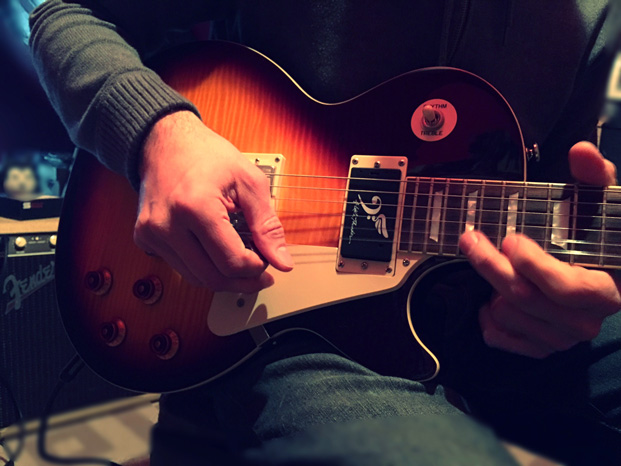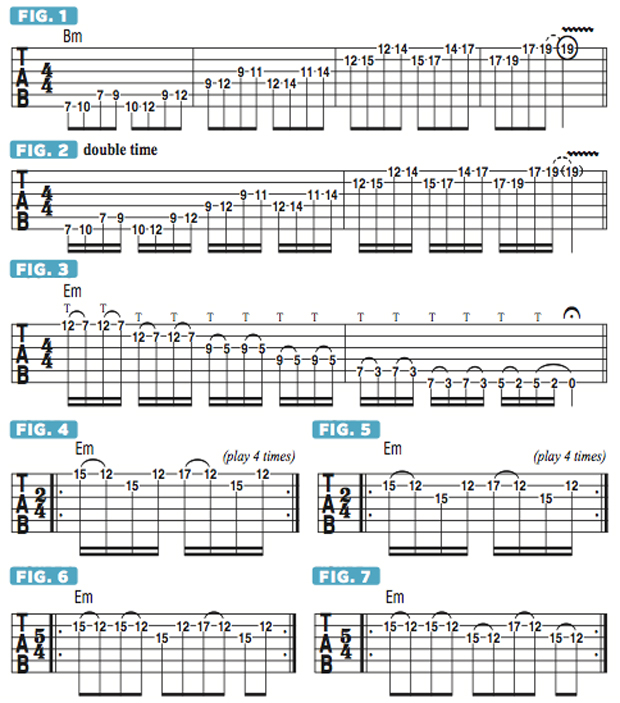How to Reinvent the Penatonic Approach to Forge New Melodic Riffs

By far the most prominently used scale and the most prevalent sound in rock, metal and blues is that of the minor pentatonic scale.
The series of intervals that comprises the minor pentatonic scale—1 (root), b3 (flatted third, 4, 5 b7 (flatted seventh)—is the structure upon which so many classic rock and metal riffs have been based since rock and roll’s earliest days.
The musical strength of the scale lies in its simplicity, making it a perfect formula from which to try to discover interesting and new musical paths. Whether I’m trying to write new riffs for songs or composing a guitar solo, it’s always fun and challenging to build new phrases based on minor pentatonic. And you don’t necessarily have to rack your brain; sometimes the most straightforward approach is best.
For example, in FIGURE 1, I use the notes of the B minor pentatonic scale—B D E F# A—to ascend in pairs of four-note groups: I begin on the low B root note on the sixth string and ascend through the first four notes on the scale, B D E F#, and then shift up a few frets and do the same thing starting on the next scale degree, the minor third, D, and play the notes D E F# A. In bar 2 I repeat the entire eight-note pattern an octave higher on the middle two strings, and then up another octave in bar 3, on the top two strings.
The interesting thing that happens with this pattern is you begin with a four-note climb followed by three eight-note climbs, which creates an interesting and somewhat predictable melodic contour. In FIGURE 2, I play the same phrase but ramp up the tempo so that it’s executed in straight 16th notes. Once you have the pattern down, try playing it in other keys and areas of the fretboard.
Let’s now take this repeating-pattern approach and apply it to a fretboard-tapping run. In FIGURE 3, I begin with taps and pull-off riffs that fall on the top two strings, starting on the high E and moving over to the B: after the initial 12th-fret tap, I pull off to my fret-hand index finger at the seventh fret. Each tap and pull-off is repeated before moving down to the next lower string. The approach used for this run is more about visual fretboard symmetry than staying within the structure of any particular scale.
After toggling between the 12th and seventh frets for the first two shapes, I move over to the G and D strings and alternate between the ninth and fifth frets in the same manner. The run concludes on the bottom two strings by moving between the seventh and third frets, and then the fifth and second frets on the sixth string before a final pull-off to the open low E. Another great way to permutate from a basic minor pentatonic idea is to simply move its shape to different strings. FIGURE 4 offers a common metal-type soloing phrase played on the top two strings.
In FIGURE 5, I take the same shape and move it to the B and G strings, which results in the inclusion of the flatted fifth, Bb. This is a great, twisted sound, one used to great effect by players like Dave Mustaine, Alexi Laiho and Dimebag Darrell. A simple alteration in the sequence of notes results in FIGURES 6 and 7, wherein the lick is reconfigured in 5/4 meter.

Get The Pick Newsletter
All the latest guitar news, interviews, lessons, reviews, deals and more, direct to your inbox!







![Joe Bonamassa [left] wears a deep blue suit and polka-dotted shirt and plays his green refin Strat; the late Irish blues legend Rory Gallagher [right] screams and inflicts some punishment on his heavily worn number one Stratocaster.](https://cdn.mos.cms.futurecdn.net/cw28h7UBcTVfTLs7p7eiLe.jpg)


